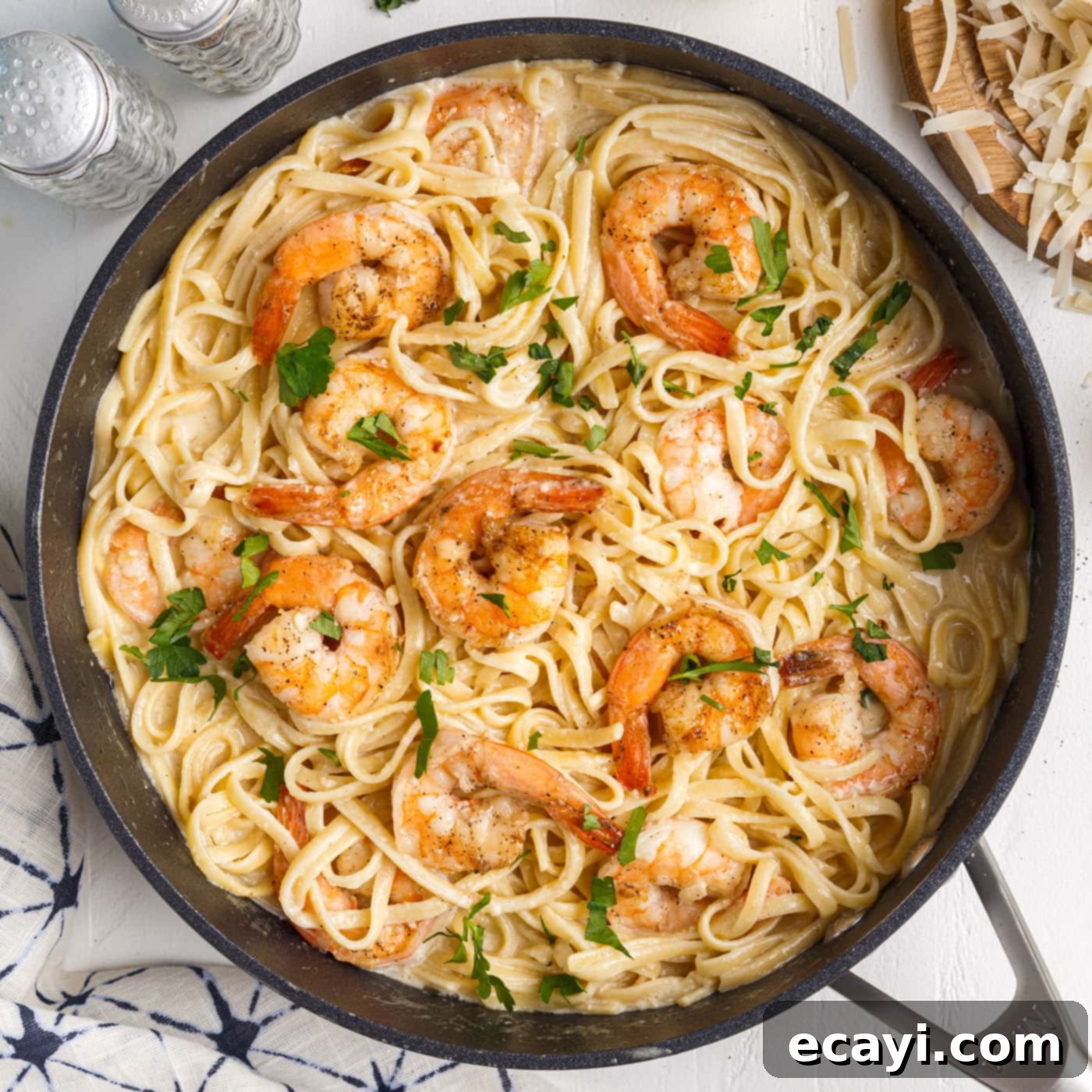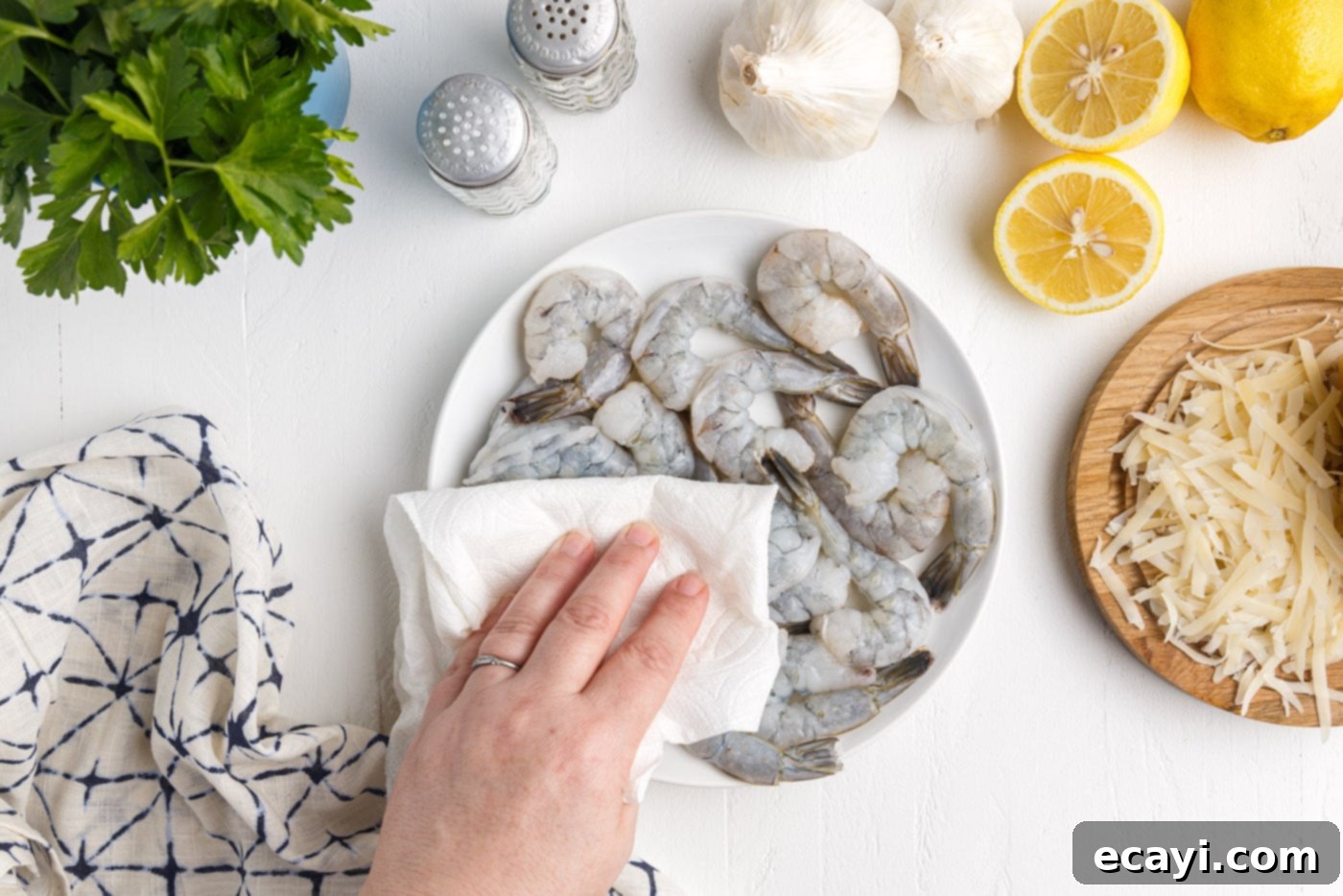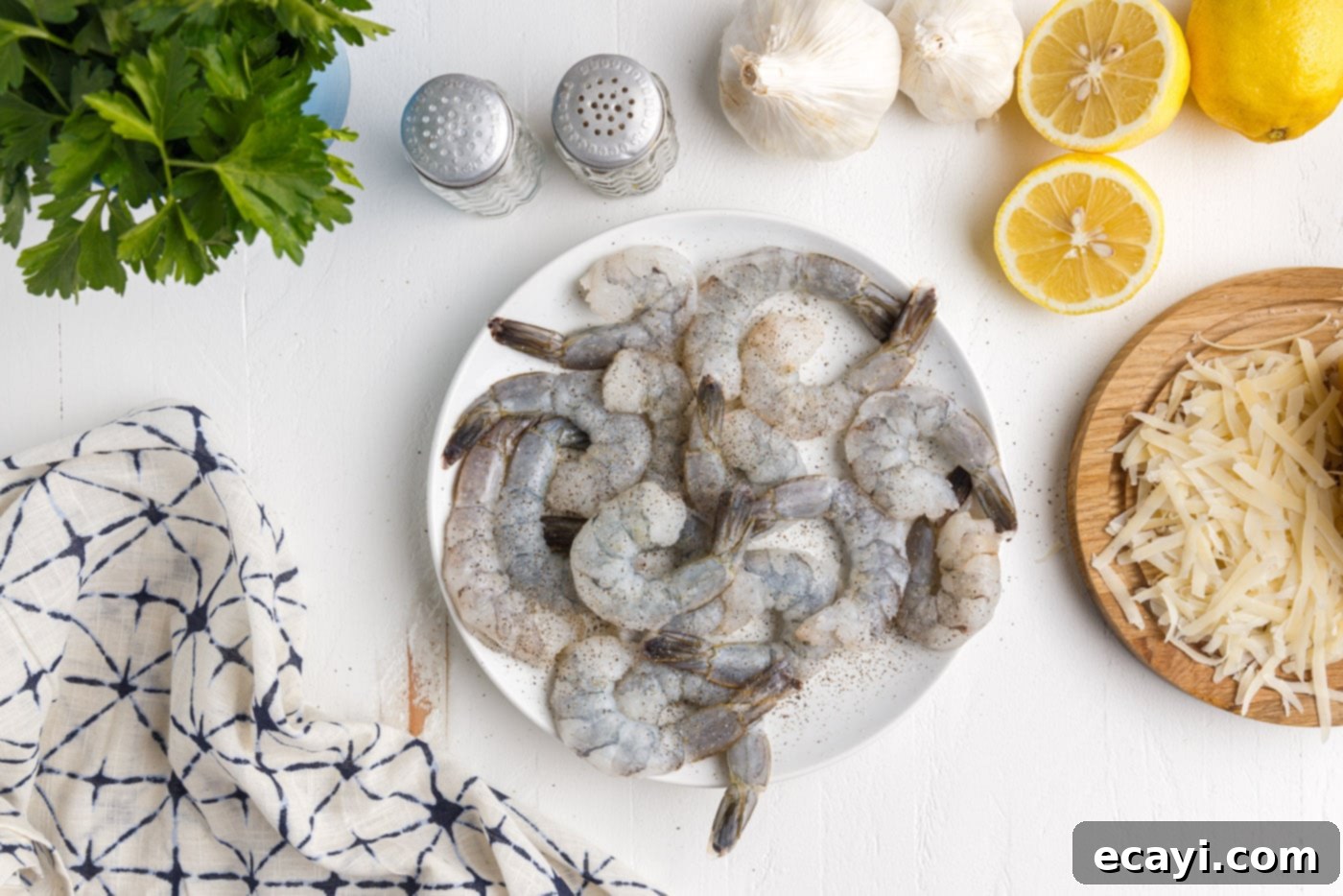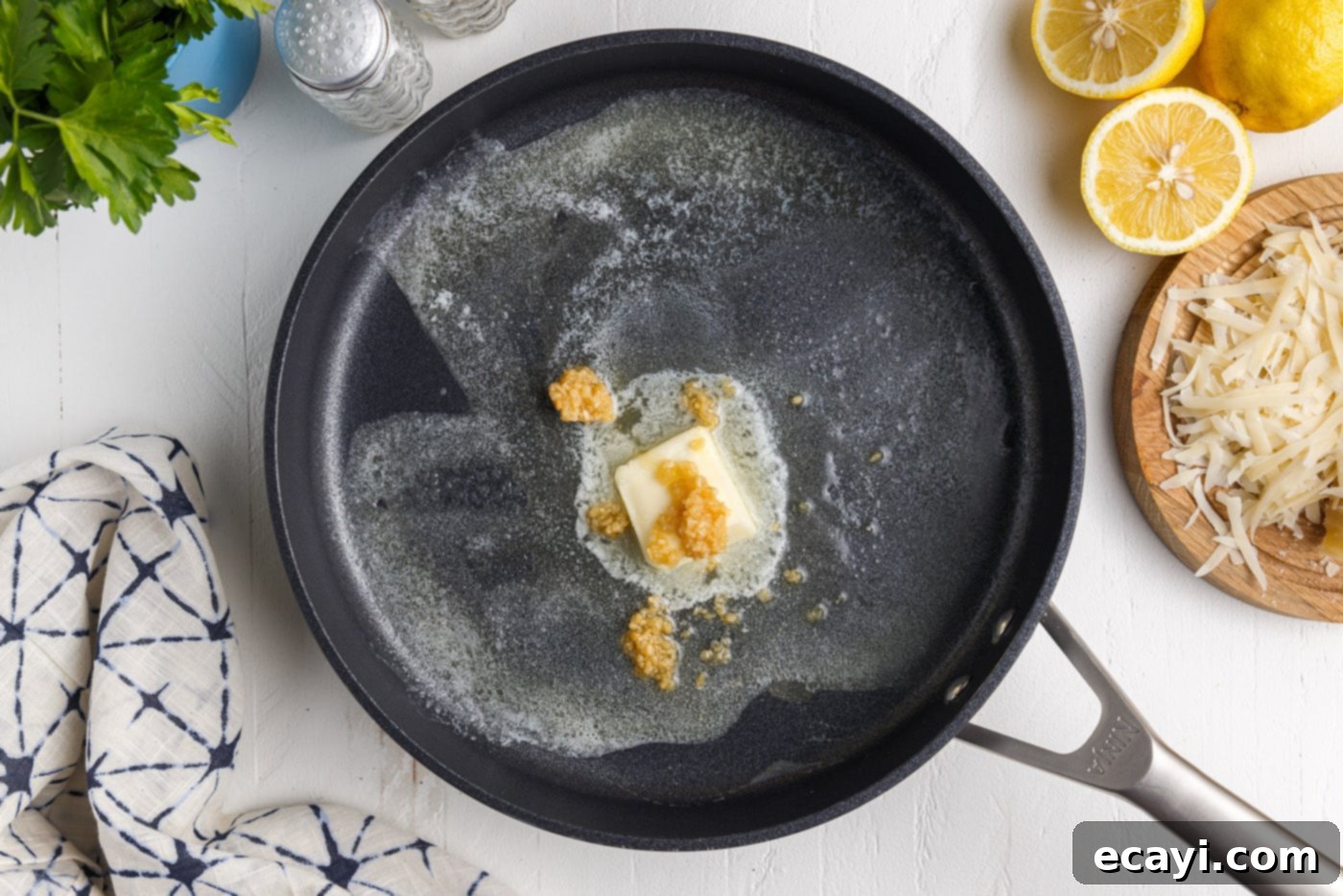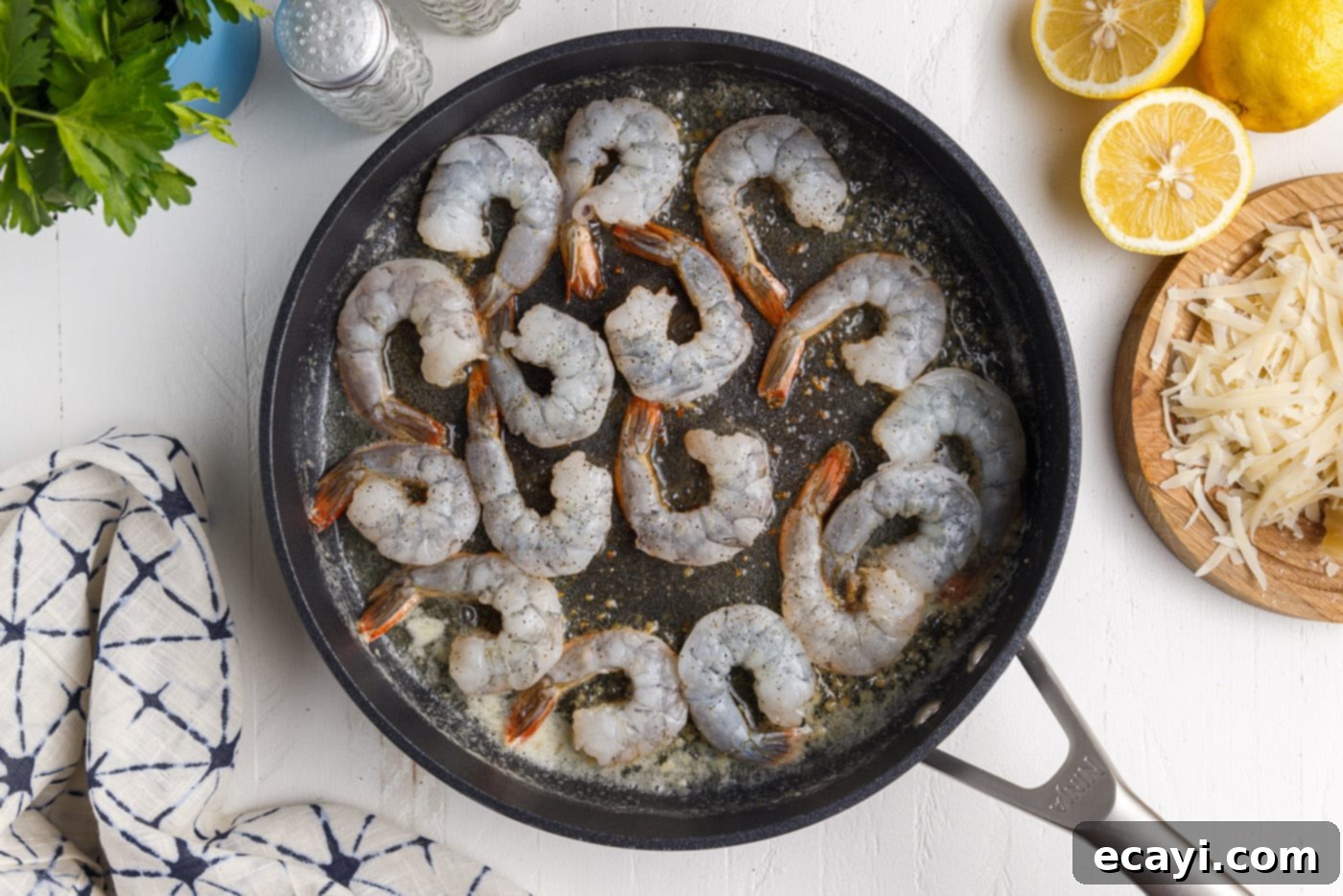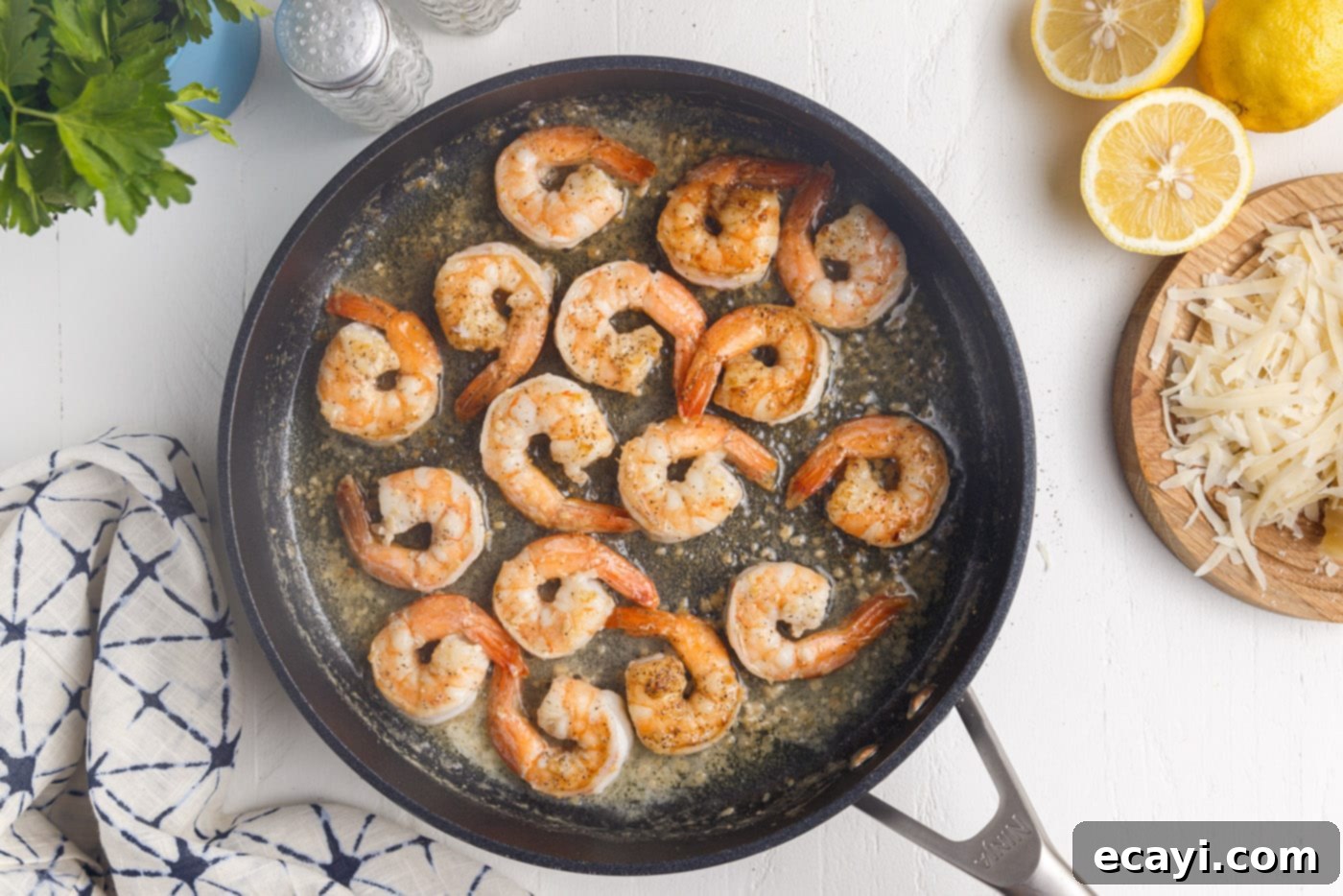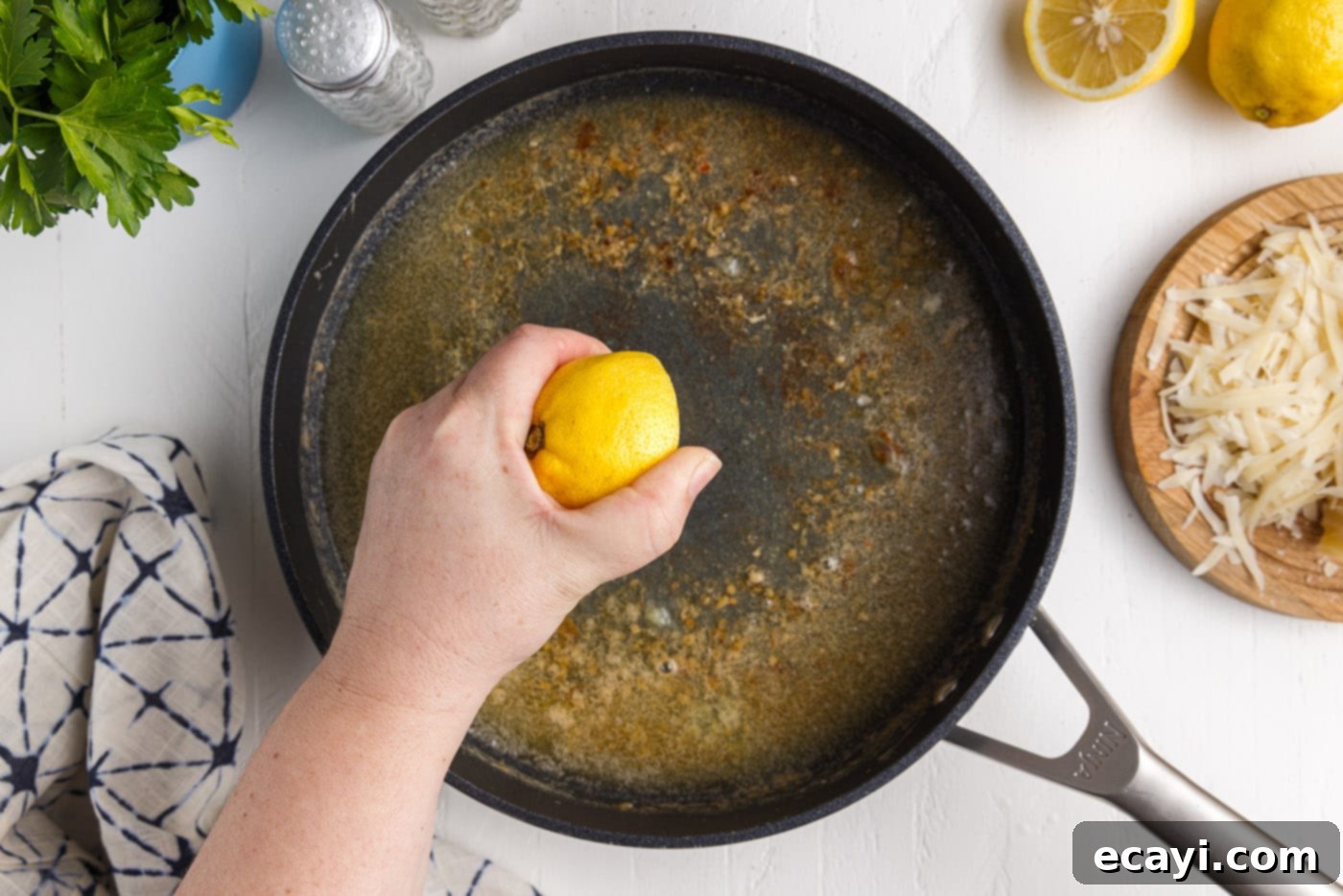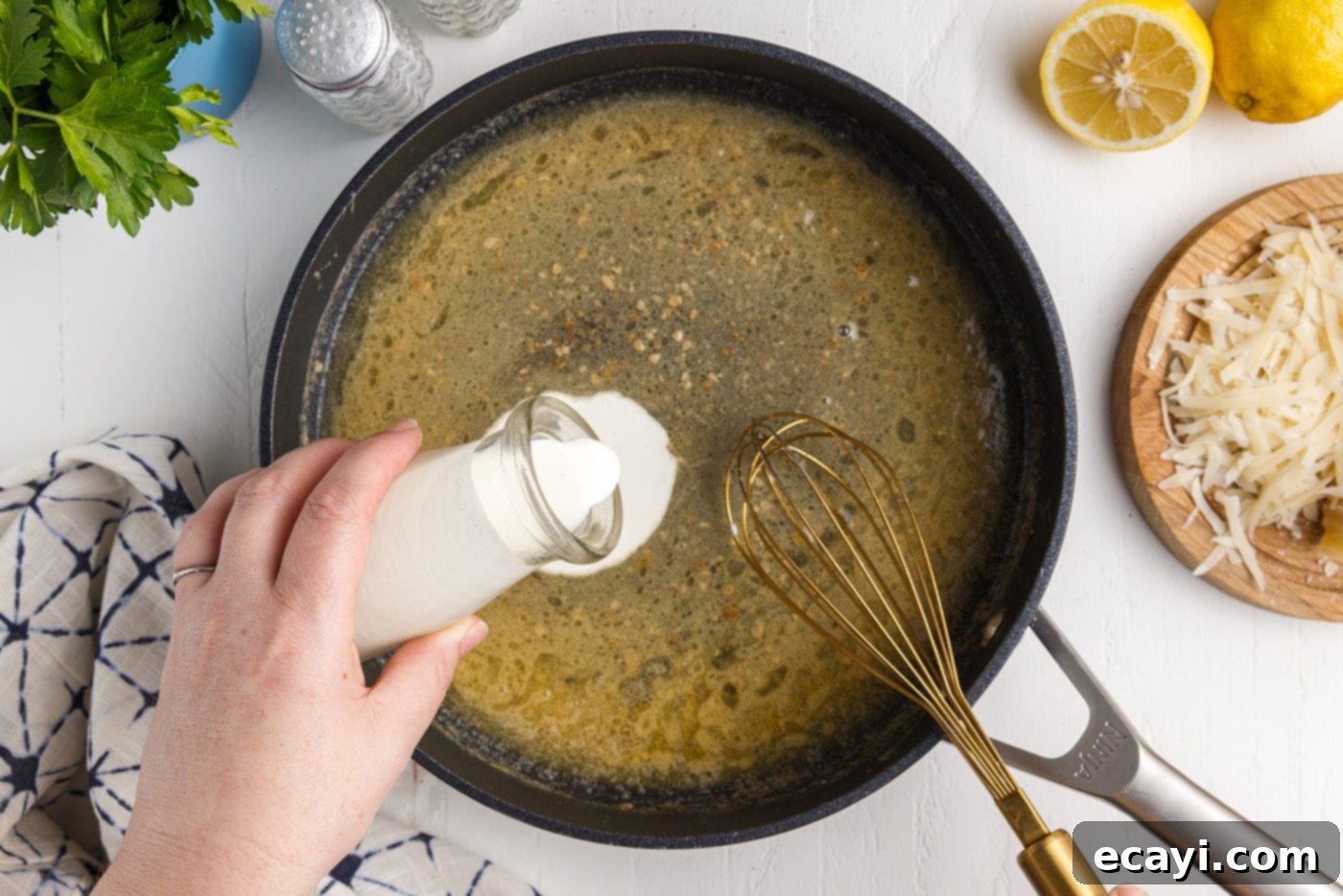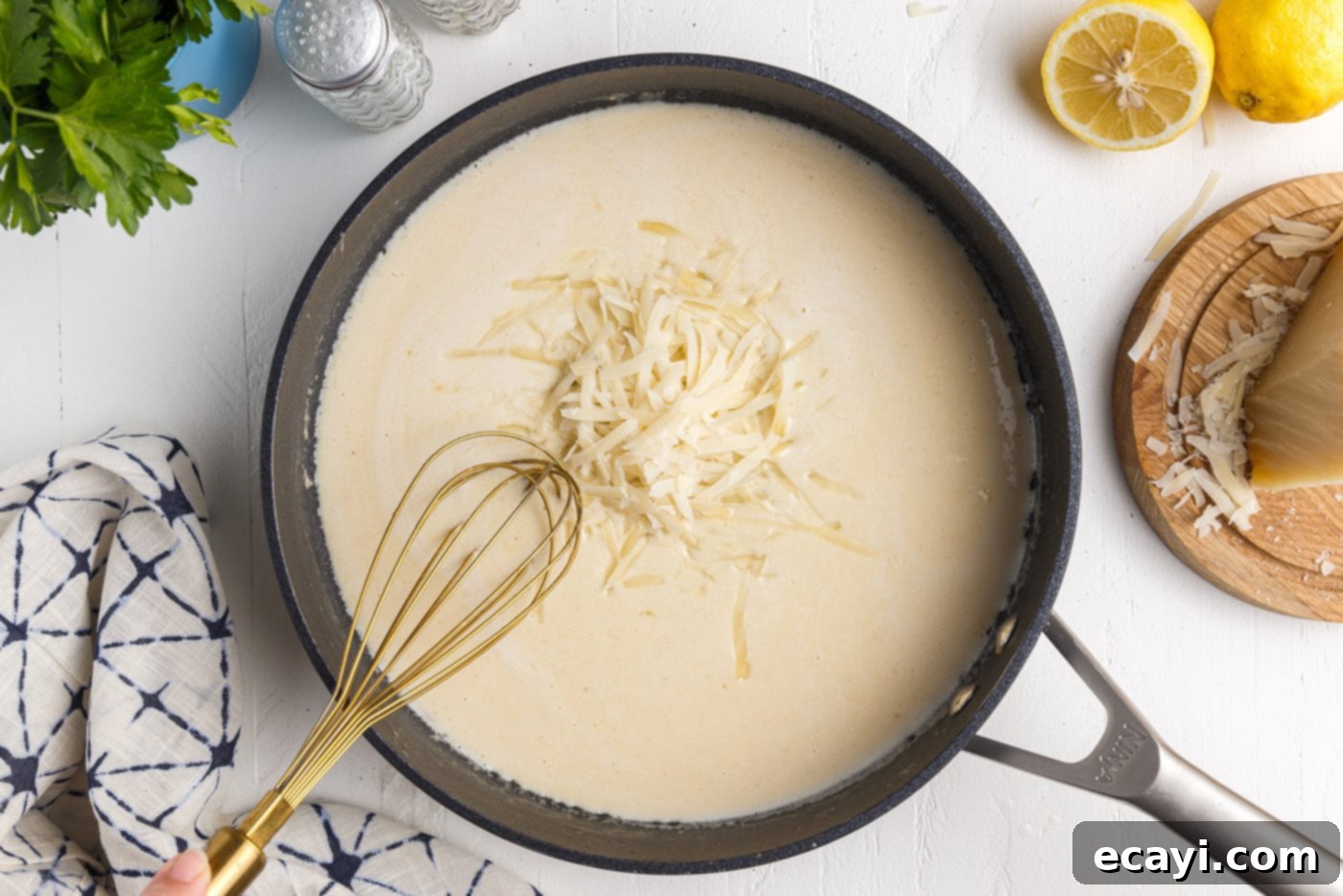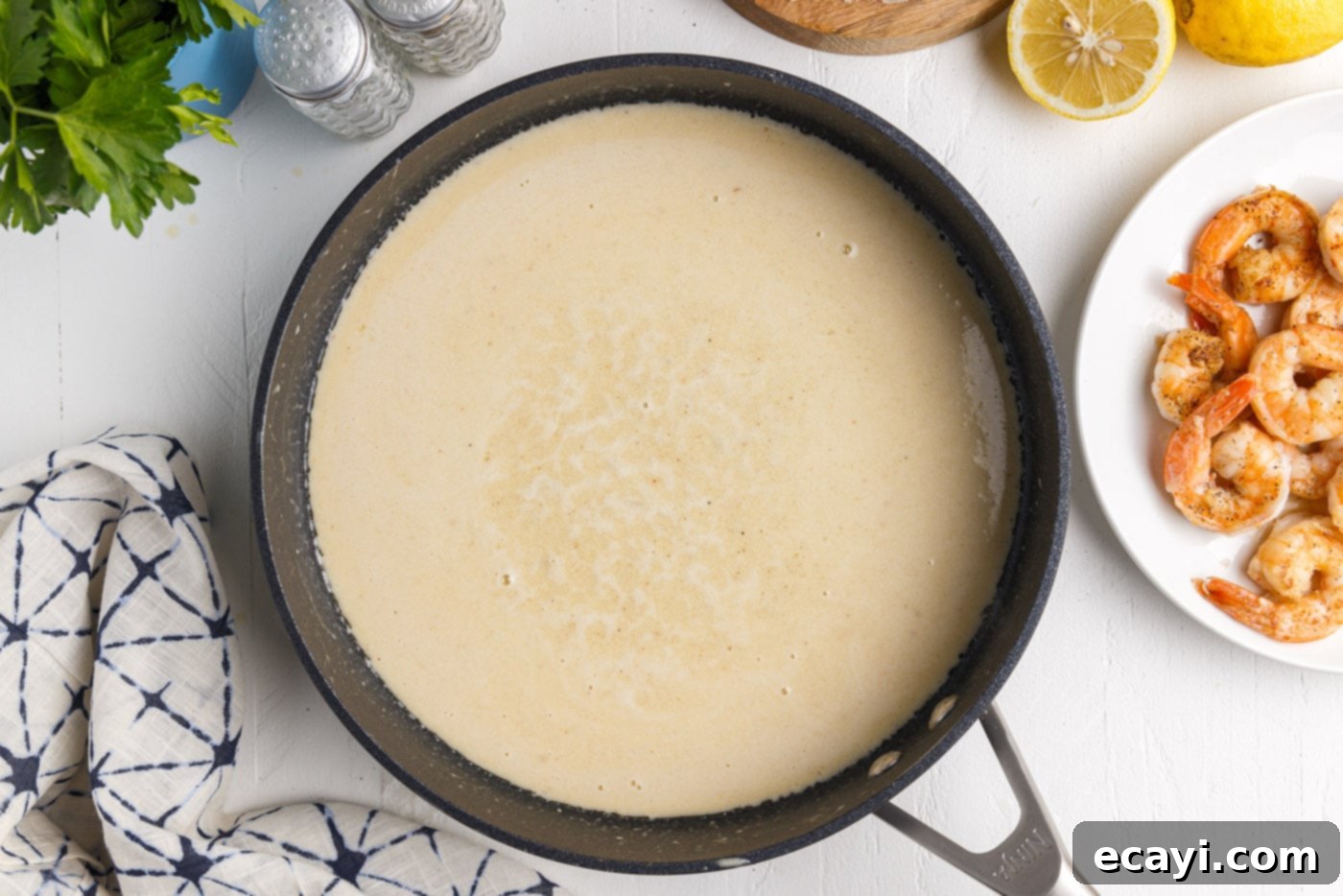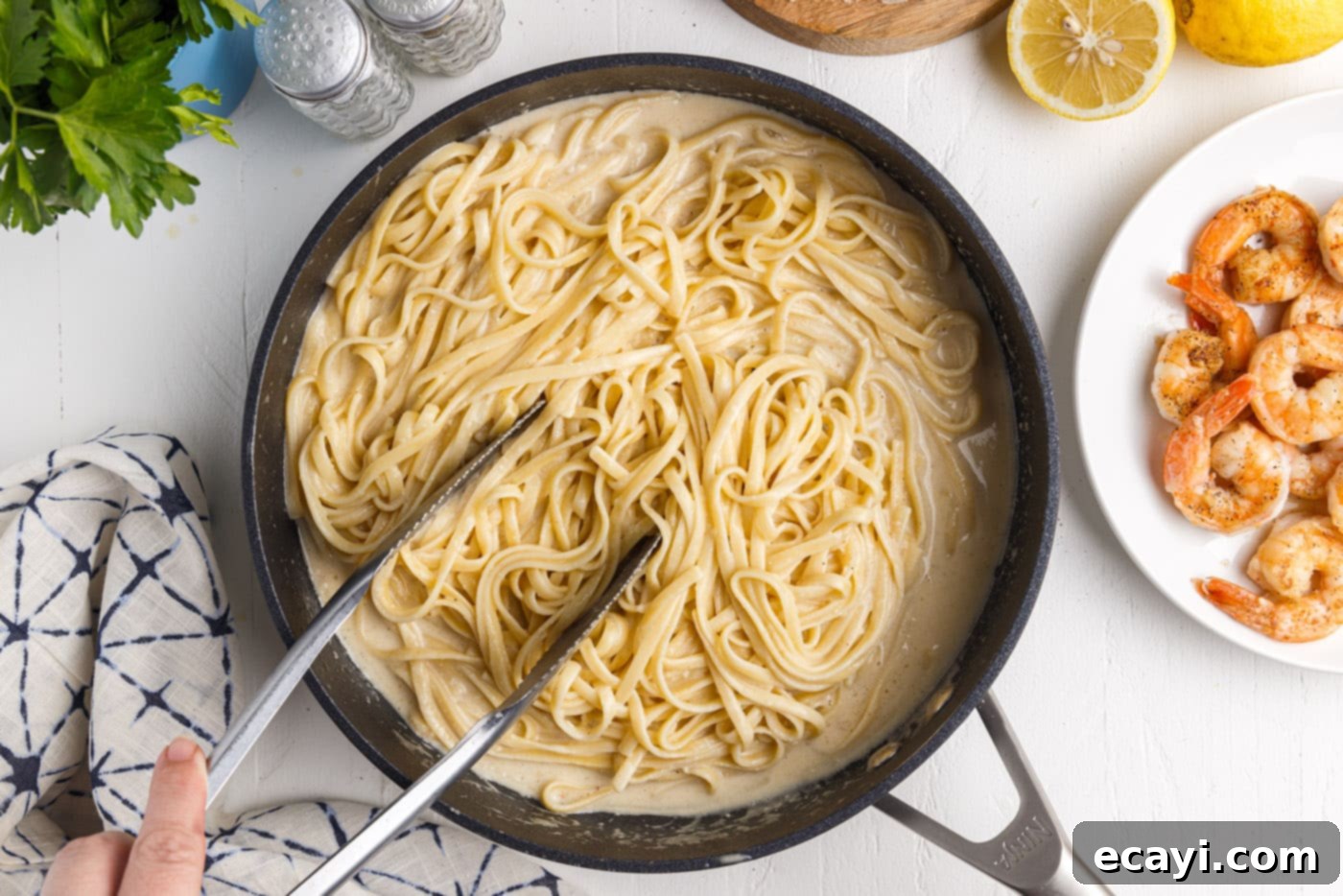Creamy Lemon Garlic Shrimp Pasta: An Easy & Flavorful Linguine Recipe
Indulge in a truly delightful meal that brings gourmet flavors to your dinner table with minimal effort. This incredible shrimp pasta dish features tender linguine noodles generously coated in a luscious, creamy lemon garlic sauce, crowned with perfectly cooked, juicy jumbo shrimp. It’s an effortlessly elegant meal, incredibly simple to prepare, requiring only a handful of ingredients, yet delivering an explosion of sophisticated flavors that will impress everyone at your table. Whether you’re planning a romantic dinner or a quick weeknight family meal, this recipe promises big taste and easy execution, making it a staple in your culinary repertoire.
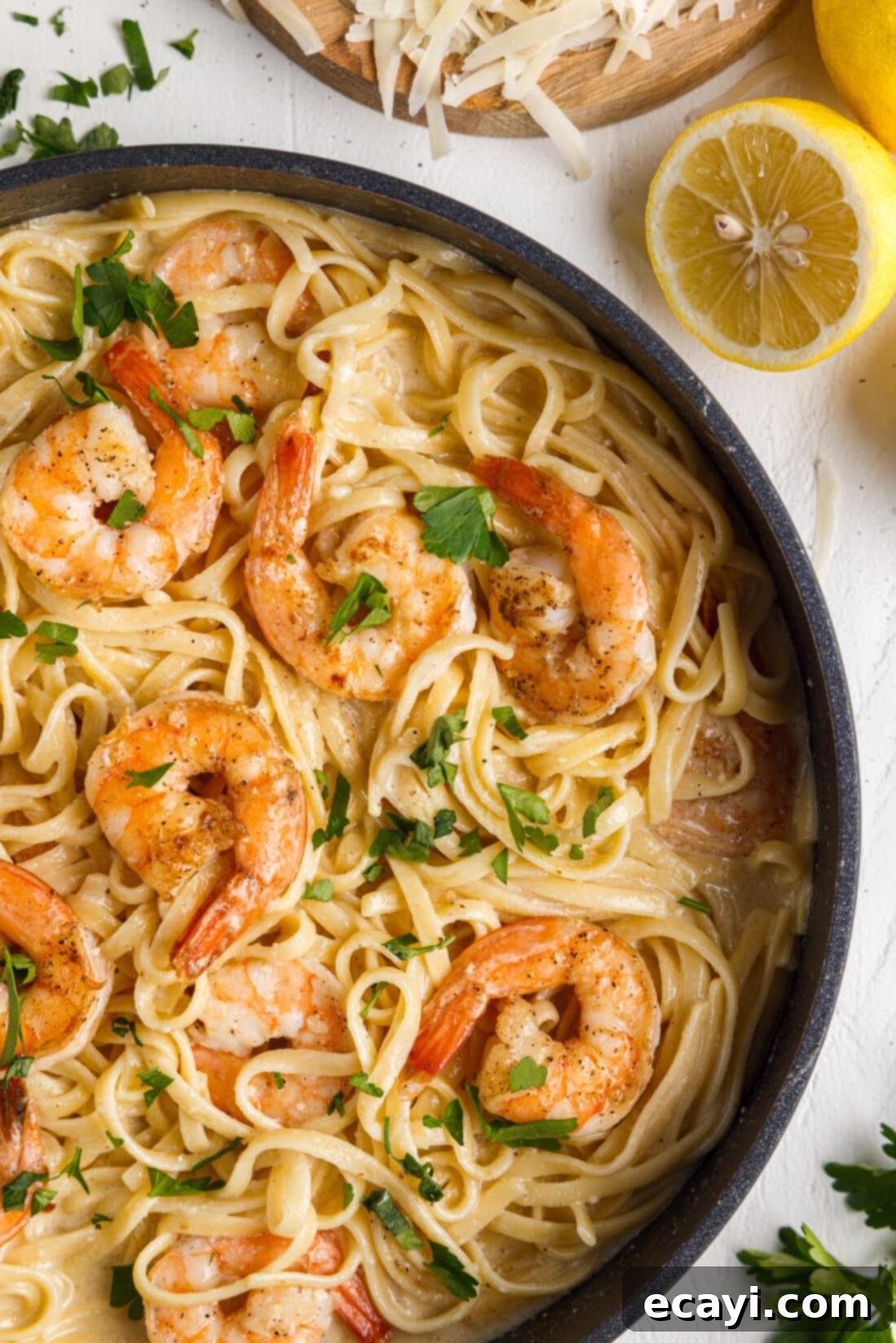
Why This Creamy Lemon Garlic Shrimp Pasta Recipe Works
This creamy lemon garlic shrimp pasta isn’t just another dinner recipe; it’s a culinary triumph born from simplicity and bold flavors. The true star of this dish is undoubtedly the decadent, velvety sauce. It’s a masterful blend of rich butter, bright lemon zest and juice, aromatic garlic, and luxurious heavy cream, all coming together in a symphony of tastes that you’ll understand from the very first aroma. This sauce isn’t just a coating; it’s an embrace that perfectly complements the delicate chew of tender linguine noodles and the succulent plumpness of perfectly cooked shrimp.
What makes this dish truly exceptional is its harmonious balance. The acidity from the lemon cuts through the richness of the cream and butter, preventing the sauce from feeling too heavy, while the garlic provides a comforting, aromatic warmth. The quick cooking time of both the shrimp and pasta makes this an ideal meal for busy weeknights, yet its elegant presentation and complex flavor profile make it suitable for special occasions. It’s a filling, satisfying, and utterly delicious pasta dish that will quickly become a cherished favorite in your household. Prepare to see for yourself how effortlessly a few simple ingredients can create such an unforgettable dining experience.
Looking to switch up the flavors slightly without completely reinventing the wheel? While this lemon garlic sauce is divine as is, consider pairing it with my chili lime shrimp for an unexpected yet equally delicious twist. The subtle heat and zesty lime would offer a fantastic counterpoint to the creamy base, creating an entirely new dimension of flavor!
RELATED: You might also enjoy this quick and versatile recipe – Sautéed Shrimp.
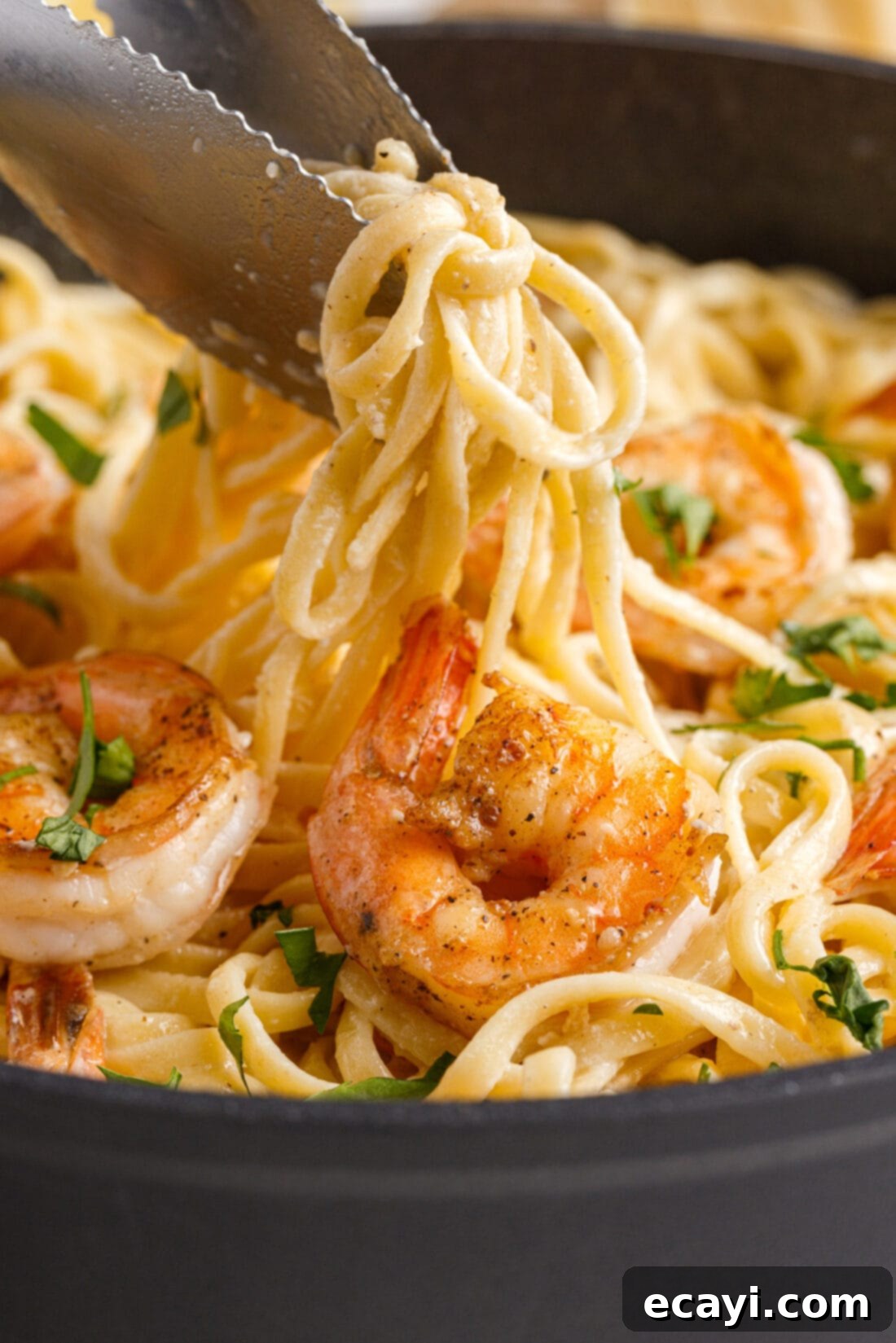
Ingredients You Will Need for This Delicious Shrimp Pasta
Crafting this sensational creamy lemon garlic shrimp pasta requires a short list of accessible ingredients, many of which you likely already have in your pantry. To ensure you have everything at your fingertips, you can find all precise measurements, a comprehensive ingredient list, and detailed instructions in the printable recipe card located at the very end of this blog post. This ensures you can easily reference the recipe as you cook, without missing a beat.
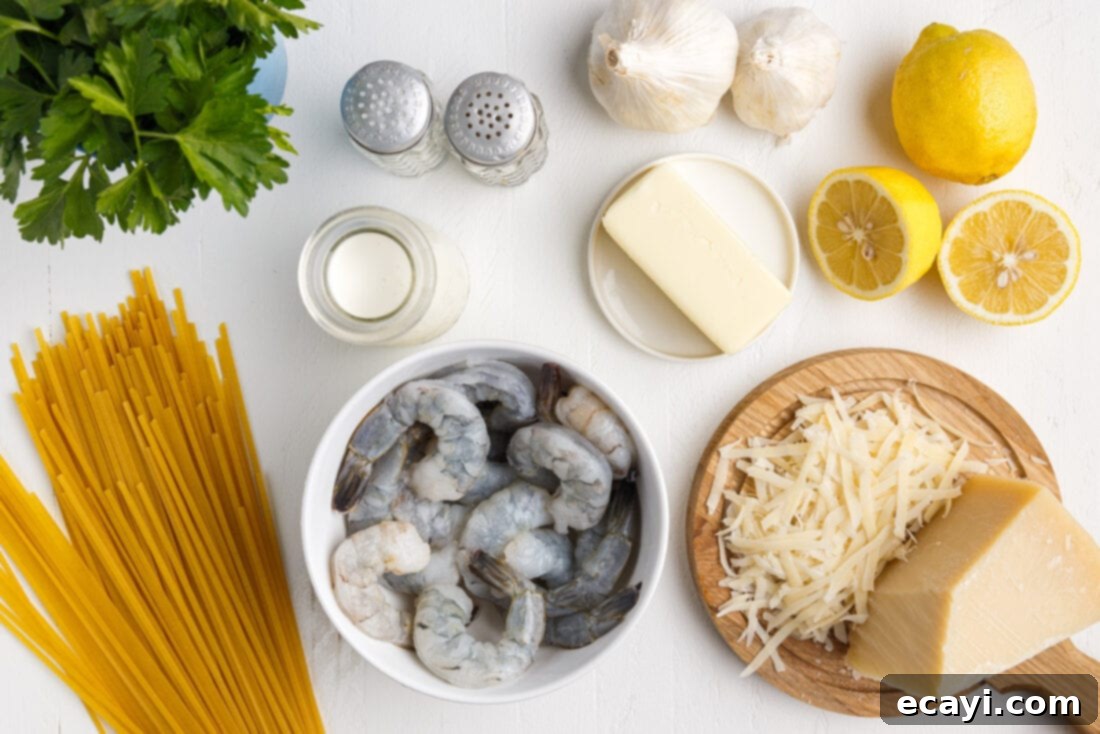
Ingredient Information and Smart Substitution Suggestions
Understanding your ingredients is key to culinary success, and often, there are clever substitutions that can make a dish even more personal or accommodate dietary needs.
SHRIMP – The quality of your shrimp significantly impacts the final dish. Shrimp are categorized by how many individual shrimp make up a pound – meaning a lower number indicates larger shrimp. For this recipe, I recommend using 21-25 count shrimp (meaning 21 to 25 shrimp per pound) for that satisfying jumbo bite. You can absolutely use either frozen or fresh shrimp. If opting for frozen, it is crucial to allow them to thaw completely before you begin cooking. Thawing can be done overnight in the refrigerator or more quickly under cold running water. Ensure they are peeled and deveined for the best experience. If shrimp isn’t your preference, this recipe can be adapted with scallops, chunks of firm white fish, or even chicken for a creamy lemon garlic chicken pasta.
PASTA – Linguine is specified here, and its flat, slightly wide shape is perfect for holding onto the creamy sauce. However, feel free to experiment with other pasta shapes. Fettuccine or spaghetti would provide a similar experience, while shorter pasta like penne, rotini, or even farfalle (bow-tie pasta) would also work beautifully, offering a different texture and ease of eating. The key is to cook your pasta al dente – tender but still with a slight bite – as it will finish cooking slightly in the sauce.
BUTTER – Unsalted butter is preferred as it gives you complete control over the dish’s saltiness. If you only have salted butter, simply reduce the amount of added salt in the recipe. The butter contributes significantly to the richness and flavor foundation of the sauce.
GARLIC – Fresh garlic is non-negotiable for the best flavor in this dish. Minced garlic offers a potent aroma and taste. While pre-minced garlic can be a time-saver, nothing compares to the vibrant flavor of freshly minced cloves. You could also thinly slice the garlic for a slightly different texture and milder garlic flavor.
LEMON JUICE – Freshly squeezed lemon juice is paramount here. Bottled lemon juice often contains preservatives and lacks the bright, zesty notes that truly elevate this sauce. For an even more intense lemon flavor, consider adding a teaspoon of fresh lemon zest to the sauce along with the juice. This adds a beautiful aromatic quality without extra acidity.
HEAVY WHIPPING CREAM – This is what gives the sauce its signature luxurious, creamy texture. Heavy cream has a high fat content, which prevents it from curdling and provides that rich mouthfeel. While you could technically use half-and-half or whole milk for a lighter sauce, be aware that the texture will be thinner, and there’s a higher risk of curdling if overheated. Full-fat heavy cream is highly recommended for the best results.
PARMESAN CHEESE – Always opt for freshly grated Parmesan cheese. Pre-grated cheeses often contain anti-caking agents that can make your sauce gritty and prevent smooth melting. A block of good quality Parmesan grated just before adding will melt beautifully into the sauce, contributing a wonderful salty, umami depth.
OPTIONAL ADDITIONS – For an extra layer of flavor, a splash of dry white wine (like Pinot Grigio or Sauvignon Blanc) can be added to the pan after sautéing the garlic, allowing it to reduce slightly before adding the cream. A pinch of red pepper flakes can introduce a subtle warmth, while fresh herbs like chopped dill or basil stirred in at the end can add freshness.
How to Make Creamy Lemon Garlic Shrimp Pasta: Step-by-Step Guide
These step-by-step photos and detailed instructions are provided to help you visualize each stage of making this incredibly satisfying shrimp pasta. For a convenient printable version of this recipe, complete with precise measurements and full instructions, simply Jump to Recipe at the bottom of this post.
- Prepare the Shrimp: If using frozen shrimp, ensure they are completely thawed. Thoroughly peel and devein them. This step is crucial for both taste and texture. Once prepared, place the shrimp on several layers of paper towels. Using additional paper towels, blot the shrimp until they are as dry as possible. Removing excess moisture is key to achieving a beautiful sear rather than steaming them.

- Season the Shrimp: Lightly sprinkle both sides of the dried shrimp with salt and freshly ground black pepper. This simple seasoning enhances their natural flavor and prepares them for searing.

- Cook the Linguine: Bring a large pot of generously salted water to a rolling boil. Add the linguine and cook according to package directions until it reaches your desired tenderness, typically al dente. Before draining the pasta, remember to reserve one cup of the starchy pasta water. This “liquid gold” will be essential for creating the perfect consistency in your sauce. Drain the remaining pasta thoroughly.
- Sauté Garlic and Sear Shrimp: While the pasta cooks, begin preparing the shrimp and sauce base. In a large saucepan or skillet, melt 4 tablespoons of unsalted butter over medium heat. Once the butter is shimmering, add the minced garlic to the pan and sauté for a brief 30 seconds until fragrant. Be careful not to burn the garlic. Immediately add the seasoned shrimp to the pan in a single layer, ensuring not to overcrowd the pan. If necessary, cook the shrimp in batches to allow them to sear properly. Let them cook undisturbed until they turn fully pink and develop a beautiful, slightly golden-brown crust on one side (this usually takes about 2 minutes). Quickly flip each shrimp to the other side and continue cooking for another 1-2 minutes until they are entirely pink and opaque throughout. Overcooked shrimp become tough and rubbery, so watch them closely. As soon as they are cooked, immediately remove the shrimp from the skillet and set aside.



- Prepare the Creamy Lemon Garlic Sauce: Using the same pan (don’t clean it, those bits of flavor are delicious!), melt the remaining 4 tablespoons of butter. Once melted, add the fresh lemon juice, then slowly whisk in the heavy cream. Bring this mixture to a gentle, low simmer, allowing the flavors to meld and the sauce to begin thickening slightly.


- Incorporate Parmesan: Reduce the heat to low and add the freshly grated Parmesan cheese to the simmering sauce. Whisk continuously until the cheese is fully melted and incorporated, creating a smooth, velvety consistency. The sauce should be rich and fragrant.


- Combine Pasta and Shrimp: Add the cooked linguine pasta directly into the sauce. Begin stirring gently to coat every strand thoroughly. Now, slowly incorporate the reserved pasta water, adding it a little at a time until the sauce reaches your desired consistency – smooth, creamy, and clinging beautifully to the pasta. Finally, add the cooked shrimp back into the pan. Toss gently just long enough to reheat the shrimp without overcooking them, about 30 seconds to 1 minute.

- Serve Immediately: Transfer the creamy lemon garlic shrimp pasta to serving bowls. Garnish generously with fresh lemon wedges, a sprinkle of vibrant chopped parsley, and an extra dusting of freshly grated Parmesan cheese, if desired. Serve warm and enjoy!
Frequently Asked Questions & Expert Tips for Perfect Shrimp Pasta
Store any leftover shrimp pasta in an airtight container in the refrigerator for up to 3 days. When reheating, do so gently over low heat on the stovetop or in the microwave, adding a splash of broth or water if the sauce has thickened too much. Be careful not to overcook the shrimp during reheating, as they can become rubbery.
To achieve your preferred consistency for the creamy lemon garlic sauce, simply add more of the reserved pasta water, a tablespoon at a time, until it’s just right. The starch in the pasta water helps to emulsify the sauce, making it silky smooth and preventing it from becoming overly thick or clumpy. If you’ve forgotten to reserve pasta water, a splash of warm chicken broth or even a little milk can work in a pinch, though the pasta water is ideal. Remember that the sauce will naturally thicken as it cools, so it’s always better to err on the side of slightly looser when serving.
Rubbery shrimp are a common issue and almost always indicate overcooking. Shrimp cook very quickly, usually in just 2-3 minutes per side, depending on their size. They are done when they curl into a C-shape and turn opaque pink. Immediately remove them from the heat once cooked to maintain their tender, juicy texture. Working in batches if your pan isn’t large enough to avoid overcrowding also helps prevent steaming instead of searing.
Absolutely! This creamy lemon garlic shrimp pasta is wonderfully adaptable to include your favorite vegetables. Spinach or baby arugula can be wilted directly into the sauce just before adding the pasta. Cherry tomatoes, halved, can be tossed in at the very end for a burst of freshness. Steamed asparagus tips, peas, or finely diced zucchini are also fantastic additions. For heartier vegetables like broccoli florets, it’s best to blanch or roast them separately and then fold them into the finished pasta dish.
To make this dish gluten-free, simply substitute the linguine with your favorite gluten-free pasta. The cooking method remains the same. For a dairy-free version, you’ll need to make a few more adjustments. Replace butter with a dairy-free butter alternative or olive oil. Heavy cream can be swapped for a full-fat canned coconut cream (note that this will impart a subtle coconut flavor) or a homemade cashew cream. Dairy-free Parmesan substitutes are also available, though the flavor profile will differ slightly from traditional Parmesan.
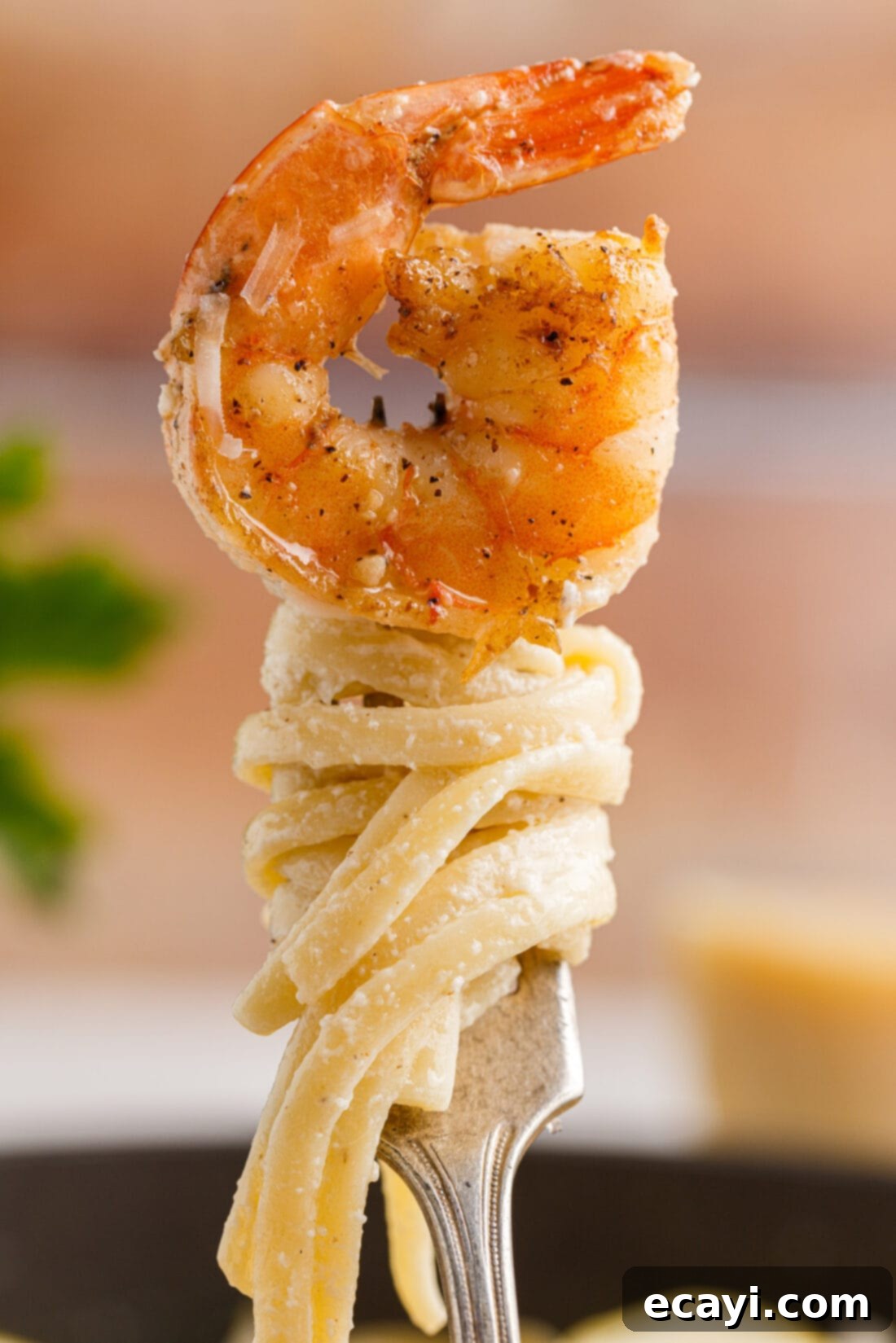
Elevate Your Meal: Serving Suggestions
While this creamy lemon garlic shrimp pasta is incredibly satisfying and quite filling on its own, a few thoughtful accompaniments can truly complete the dining experience. For a classic pairing, parmesan garlic rolls or rich garlic cheese rolls are always a welcome addition, perfect for soaking up every last drop of that delectable sauce. A light, crisp side salad with a simple vinaigrette offers a refreshing contrast and helps balance the richness of the pasta. Think mixed greens, cherry tomatoes, and cucumber for a vibrant touch.
Beyond bread and salad, consider serving this dish with a side of perfectly steamed or roasted green beans, asparagus, or broccoli florets for added nutrition and color. A glass of crisp, dry white wine like a Sauvignon Blanc, Pinot Grigio, or an unoaked Chardonnay would beautifully complement the lemon and garlic flavors. For a non-alcoholic option, sparkling water with a slice of lemon is always a good choice. Always serve this delightful dish warm, ensuring to garnish with extra chopped fresh parsley, an additional sprinkle of freshly grated Parmesan cheese, and a fresh lemon wedge for that final touch of zest and visual appeal.
Explore More Delicious Pasta Recipes
If you’re a pasta enthusiast like us, you’ll love diving into these other fantastic recipes:
- Pasta Primavera: A vibrant, fresh pasta dish bursting with seasonal vegetables.
- Bolognese Sauce: A rich, hearty meat sauce perfect for any pasta shape.
- Mushroom Ravioli: Comfort food at its finest, with earthy mushroom flavors.
- Sun Dried Tomato Pesto: A flavorful alternative to traditional pesto, packed with umami.
- Simple Zucchini Tomato Pasta: A light and fresh dish, perfect for summer evenings.
- Pasta Carbonara: A classic Italian favorite, creamy and indulgent with crispy pancetta.
- Cajun Chicken Pasta: A spicy and creamy pasta dish with tender chicken.
- Shrimp Scampi Pasta: Another quick and zesty shrimp and pasta combination.
I absolutely love to bake and cook, and my greatest joy is sharing my kitchen experiences and delicious recipes with all of you! Remembering to come back each day for new culinary inspiration can be tough, which is why I offer a convenient newsletter every time a new recipe posts. Simply subscribe today and start receiving your free daily recipes directly to your inbox!
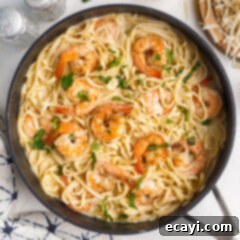
Shrimp Pasta
IMPORTANT – There are often Frequently Asked Questions within the blog post that you may find helpful. Simply scroll back up to read them!
Print It
Pin It
Rate It
Save ItSaved!
Ingredients
- ¾ lb jumbo shrimp raw, deveined
- salt and pepper to taste
- ½ cup unsalted butter divided
- 4 cloves garlic minced
- 4 Tbsp lemon juice fresh, about 2 – 2 1/2 lemons
- ⅓ cup heavy whipping cream
- ⅓ cup parmesan freshly grated
- 8 oz linguini pasta
- fresh parsley chopped, for garnish
Things You’ll Need
-
Large skillet
Before You Begin
- To achieve perfectly seared shrimp, ensure the garlic butter is nice and hot, and that your shrimp are thoroughly dry and pre-seasoned. Place them in the pan in a single layer without excessive stirring or moving. If needed, work in batches to avoid overcrowding, which can cause them to steam rather than sear. The entire process for the shrimp should take no more than 4-5 minutes, ensuring they remain tender and juicy.
- The reserved pasta water is your secret ingredient for a silky-smooth sauce. It helps to emulsify and loosen the sauce, preventing it from becoming too thick or clumpy. You can adjust the amount of pasta water by adding it gradually, a little at a time, until your sauce reaches the desired consistency. Keep in mind that creamy sauces tend to thicken further as they cool, so it’s best to aim for a slightly thinner consistency when first combining.
- Shrimp size can vary significantly, which impacts cooking time. They are typically labeled by the number of shrimp per pound (e.g., 21-25 count). A lower number means larger shrimp. This recipe was tested with 21-25 count jumbo shrimp, providing a substantial bite. Adjust cooking times slightly for smaller or larger shrimp.
Instructions
-
Thoroughly thaw frozen shrimp (if applicable) and ensure they are peeled and deveined. Place shrimp on several layers of paper towels and blot with additional paper towels until as dry as possible.
-
Sprinkle salt and pepper over both sides of the shrimp.
-
Bring a large pot of salted water to a boil and cook linguine to desired tenderness. Reserve one cup of the pasta water and drain the pasta.
-
Meanwhile, melt 4 tablespoons of butter in a large saucepan or skillet over medium heat. Add the minced garlic and sauté for about 30 seconds until fragrant.
-
Add shrimp to the pan in a single layer. Cook without stirring until fully pink and slightly golden brown on one side (about 2 minutes). Flip and cook another 1-2 minutes until pink/opaque throughout. Immediately remove from skillet to prevent overcooking.
-
Melt the remaining 4 tablespoons of butter in the same pan. Add lemon juice and whisk in heavy cream. Bring the sauce to a low simmer.
-
Add Parmesan cheese and whisk until the sauce is smooth and the cheese is fully melted.
-
Add cooked pasta and up to 1 cup of reserved pasta water into the sauce, stirring to coat the pasta. Add the shrimp back into the pan just long enough to gently reheat.
-
Serve immediately with lemon wedges, chopped fresh parsley, and a sprinkle of additional Parmesan cheese, if desired.
Nutrition Information
The recipes on this blog are tested with a conventional gas oven and gas stovetop. It’s important to note that some ovens, especially as they age, can cook and bake inconsistently. Using an inexpensive oven thermometer can assure you that your oven is truly heating to the proper temperature. If you use a toaster oven or countertop oven, please keep in mind that they may not distribute heat the same as a conventional full sized oven and you may need to adjust your cooking/baking times. In the case of recipes made with a pressure cooker, air fryer, slow cooker, or other appliance, a link to the appliances we use is listed within each respective recipe. For baking recipes where measurements are given by weight, please note that results may not be the same if cups are used instead, and we can’t guarantee success with that method.
